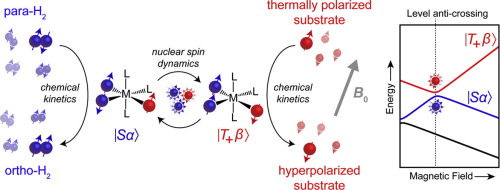当前位置:
X-MOL 学术
›
Prog. Nucl. Magn. Reson. Spectrosc.
›
论文详情
Our official English website, www.x-mol.net, welcomes your feedback! (Note: you will need to create a separate account there.)
SABRE: Chemical kinetics and spin dynamics of the formation of hyperpolarization
Progress in Nuclear Magnetic Resonance Spectroscopy ( IF 6.1 ) Pub Date : 2019-10-01 , DOI: 10.1016/j.pnmrs.2019.05.005 Danila A. Barskiy , Stephan Knecht , Alexandra V. Yurkovskaya , Konstantin L. Ivanov
Progress in Nuclear Magnetic Resonance Spectroscopy ( IF 6.1 ) Pub Date : 2019-10-01 , DOI: 10.1016/j.pnmrs.2019.05.005 Danila A. Barskiy , Stephan Knecht , Alexandra V. Yurkovskaya , Konstantin L. Ivanov

|
In this review, we present the physical principles of the SABRE (Signal Amplification By Reversible Exchange) method. SABRE is a promising hyperpolarization technique that enhances NMR signals by transferring spin order from parahydrogen (an isomer of the H2 molecule that is in a singlet nuclear spin state) to a substrate that is to be polarized. Spin order transfer takes place in a transient organometallic complex which binds both parahydrogen and substrate molecules; after dissociation of the SABRE complex, free hyperpolarized substrate molecules are accumulated in solution. An advantage of this method is that the substrate is not modified chemically, and its polarization can be regenerated multiple times by bubbling fresh parahydrogen through the solution. Thus, SABRE requires two key ingredients: (i) polarization transfer and (ii) chemical exchange of both parahydrogen and substrate. While there are several excellent reviews on applications of SABRE, the background of the method is discussed less frequently. In this review we aim to explain in detail how SABRE hyperpolarization is formed, focusing on key aspects of both spin dynamics and chemical kinetics, as well as on the interplay between them. Hence, we first cover the known spin order transfer methods applicable to SABRE - cross-relaxation, coherent spin mixing at avoided level crossings, and coherence transfer - and discuss their practical implementation for obtaining SABRE polarization in the most efficient way. Second, we introduce and explain the principle of SABRE hyperpolarization techniques that operate at ultralow (<1 μT), at low (1μT to 0.1 T) and at high (>0.1 T) magnetic fields. Finally, chemical aspects of SABRE are discussed in detail, including chemical systems that are amenable to SABRE and the exchange processes that are required for polarization formation. A theoretical treatment of the spin dynamics and their interplay with chemical kinetics is also presented. This review outlines known aspects of SABRE and provides guidelines for the design of new SABRE experiments, with the goal of solving practical problems of enhancing weak NMR signals.
中文翻译:

SABRE:超极化形成的化学动力学和自旋动力学
在这篇综述中,我们介绍了 SABRE(可逆交换信号放大)方法的物理原理。SABRE 是一种很有前途的超极化技术,它通过将自旋顺序从仲氢(处于单线态核自旋状态的 H2 分子的异构体)转移到要极化的基底来增强 NMR 信号。自旋顺序转移发生在结合仲氢和底物分子的瞬态有机金属络合物中;SABRE 复合物解离后,游离的超极化底物分子在溶液中积累。这种方法的一个优点是底物没有经过化学修饰,它的极化可以通过溶液中的新鲜仲氢鼓泡多次再生。因此,SABRE 需要两个关键要素:(i) 极化转移和 (ii) 仲氢和底物的化学交换。虽然有一些关于 SABRE 应用的优秀评论,但很少讨论该方法的背景。在这篇综述中,我们旨在详细解释 SABRE 超极化是如何形成的,重点关注自旋动力学和化学动力学的关键方面,以及它们之间的相互作用。因此,我们首先介绍适用于 SABRE 的已知自旋顺序转移方法——交叉弛豫、避免水平交叉处的相干自旋混合和相干转移——并讨论它们以最有效的方式获得 SABRE 极化的实际实现。其次,我们介绍并解释了在超低 (<1 μT)、低 (1μT 至 0.1 T) 和高 (>0. 1 T) 磁场。最后,详细讨论了 SABRE 的化学方面,包括适用于 SABRE 的化学系统和极化形成所需的交换过程。还介绍了自旋动力学及其与化学动力学相互作用的理论处理。这篇综述概述了 SABRE 的已知方面,并为新 SABRE 实验的设计提供了指导,目的是解决增强微弱 NMR 信号的实际问题。
更新日期:2019-10-01
中文翻译:

SABRE:超极化形成的化学动力学和自旋动力学
在这篇综述中,我们介绍了 SABRE(可逆交换信号放大)方法的物理原理。SABRE 是一种很有前途的超极化技术,它通过将自旋顺序从仲氢(处于单线态核自旋状态的 H2 分子的异构体)转移到要极化的基底来增强 NMR 信号。自旋顺序转移发生在结合仲氢和底物分子的瞬态有机金属络合物中;SABRE 复合物解离后,游离的超极化底物分子在溶液中积累。这种方法的一个优点是底物没有经过化学修饰,它的极化可以通过溶液中的新鲜仲氢鼓泡多次再生。因此,SABRE 需要两个关键要素:(i) 极化转移和 (ii) 仲氢和底物的化学交换。虽然有一些关于 SABRE 应用的优秀评论,但很少讨论该方法的背景。在这篇综述中,我们旨在详细解释 SABRE 超极化是如何形成的,重点关注自旋动力学和化学动力学的关键方面,以及它们之间的相互作用。因此,我们首先介绍适用于 SABRE 的已知自旋顺序转移方法——交叉弛豫、避免水平交叉处的相干自旋混合和相干转移——并讨论它们以最有效的方式获得 SABRE 极化的实际实现。其次,我们介绍并解释了在超低 (<1 μT)、低 (1μT 至 0.1 T) 和高 (>0. 1 T) 磁场。最后,详细讨论了 SABRE 的化学方面,包括适用于 SABRE 的化学系统和极化形成所需的交换过程。还介绍了自旋动力学及其与化学动力学相互作用的理论处理。这篇综述概述了 SABRE 的已知方面,并为新 SABRE 实验的设计提供了指导,目的是解决增强微弱 NMR 信号的实际问题。



























 京公网安备 11010802027423号
京公网安备 11010802027423号